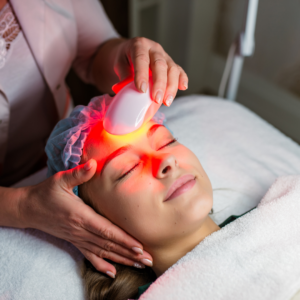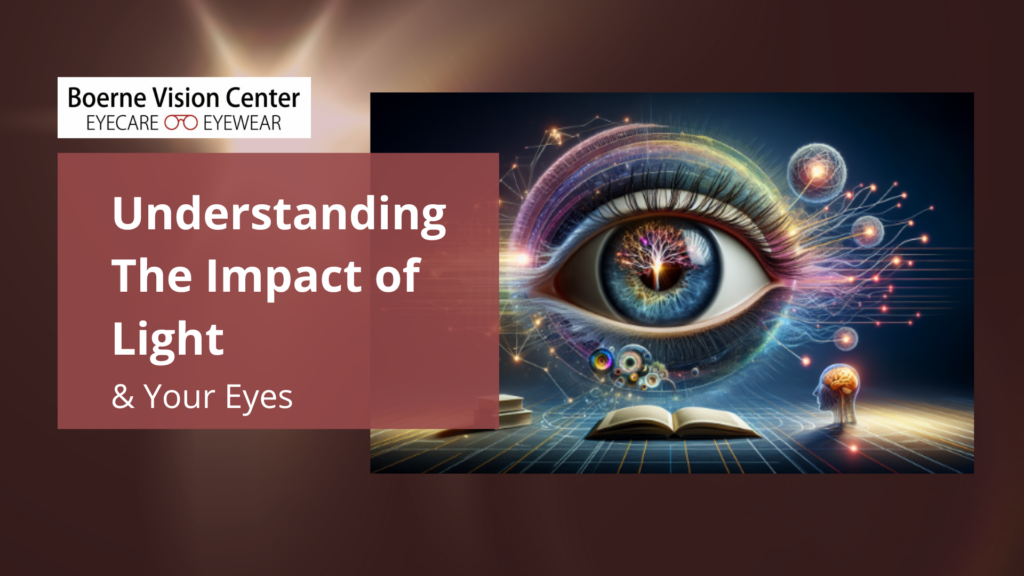Introduction
Have you ever wondered how something as ever-present as light could be affecting your eyes?  With wavelengths between 380 to 500 nanometers, blue light is a high-energy, significant part of the visible light spectrum that we’re exposed to daily, from natural sunlight to the artificial glow of our much-loved screens. This light isn’t all bad; it’s renowned for benefits like enhancing alertness, aiding memory, lifting mood, and helping to maintain our circadian rhythm, the body’s sleep-wake cycle. However, when light invades your life excessively, particularly from digital devices, it may lead to eye strain with symptoms that affect your overall well-being. Understanding how light impacts your eyes is more than just eye care—it’s a step towards holistic health.
With wavelengths between 380 to 500 nanometers, blue light is a high-energy, significant part of the visible light spectrum that we’re exposed to daily, from natural sunlight to the artificial glow of our much-loved screens. This light isn’t all bad; it’s renowned for benefits like enhancing alertness, aiding memory, lifting mood, and helping to maintain our circadian rhythm, the body’s sleep-wake cycle. However, when light invades your life excessively, particularly from digital devices, it may lead to eye strain with symptoms that affect your overall well-being. Understanding how light impacts your eyes is more than just eye care—it’s a step towards holistic health.
In this comprehensive guide, we’ll delve deeply into what makes light, particularly blue light, a double-edged sword for your ocular health. You’ll find out not just the risks posed by prolonged exposure to screens but also explore the solutions at your fingertips—from blue light blocking strategies to syncing your life with the natural rhythms of day and night. We’ll offer practical tips for protecting your eyes in the digital age, ensuring that the light in your world uplifts rather than upsets your sight. So, if you’ve pondered, “is light good for my eyes?” or “how does light impact my eyes?” you’re about to discover ways to maintain your vision’s health without shunning the devices that play a central role in your life.
Understanding Light Therapy
Delving into the realm of light therapy, or photobiomodulation (PBM), opens up a fascinating avenue for enhancing eye health. This therapeutic approach involves exposing the eyes to low-level red light, usually within the spectrum of 630 to 700 nanometers. It’s a gentle yet powerful technique that can play a pivotal role in safeguarding your vision, particularly as you age.
- Age-Related Macular Degeneration, Retinitis Pigmentosa and Glaucoma:
- PBM has shown promise for individuals with age-related macular degeneration, a leading cause of vision loss, by reducing oxidative stress in the eyes and boosting ATP energy production, which is vital for healthy cell function.
- Beyond these common eye diseases, PBM is also effective in managing retinitis pigmentosa, a degenerative disease that can severely impair night vision and potentially lead to blindness. https://www.ncbi.nlm.nih.gov/pmc/articles/PMC7738953/
- For those living with glaucoma, the benefits of red light therapy extend to protecting the cornea and retina against the damaging effects of high ocular pressure and fluid buildup, common issues in this condition. Source: https://www.aao.org/eye-health/news/red-light-protect-aging-eyes-rlt-pbm-near-infrared

- Intense Pulsed Light (IPL) therapy serves as an alternative light-based treatment, specifically targeting meibomian gland dysfunction, a predominant cause of dry eyes.
- By using visible light to alleviate inflammation, IPL therapy not only addresses the symptoms but also treats the underlying dysfunction, offering a potential cure or significant symptom reduction for those affected by dry eyes. https://www.ncbi.nlm.nih.gov/pmc/articles/PMC4298157/
- Low-level light therapy (LLLT) has anti-inflammatory properties and its role in promoting healing can be particularly beneficial for treatment of dry eye by stimulating the lacrimal gland and meibomian gland function. https://www.ncbi.nlm.nih.gov/pmc/articles/PMC8897458/
Incorporating these light-based therapies into your eye care routine can be a transformative step towards maintaining optimal ocular health. As you consider how light impacts your eyes, it’s reassuring to know that therapies like PBM and IPL are available to support the well-being of your vision. Whether you’re looking to protect against age-related conditions, manage existing eye diseases, or simply ensure that your eyes remain healthy, exploring the benefits of light therapy could be the answer you’ve been searching for.
- Myopia Control
- Progressive myopia raises the risk of irreversible visual impairment, so prevention and control are crucial. Red-Light Therapy showed that the treatment is effective, safe, and highly acceptable to users. https://www.aao.org/eyenet/article/red-light-therapy-for-myopia-control-2.
The Impact of Blue Light
As you immerse yourself in the digital world, whether for work or leisure, it’s crucial to understand how blue light affects your eyes. This component of the visible light spectrum, with wavelengths between 380 to 500 nanometers, is omnipresent in our lives, emanating from the sun as well as from screens of smartphones, computers, and TVs. Here’s what you need to know about blue light and its impact on your ocular health: 
- High-Energy Visible Light: Blue light falls under high-energy visible (HEV) light, which means it has more energy per photon of light than other colors in the visible spectrum. This high energy can be both beneficial and detrimental, depending on exposure levels.
- Potential for Eye Strain: Extensive exposure to blue light, especially from screens close to your face, can contribute to digital eye strain. Symptoms may include sore or irritated eyes and difficulty focusing. It’s not just about how much light enters your eyes, but also about how your eyes process it.
- Disruption of Sleep Patterns: Your body uses blue light to regulate your circadian rhythm—your natural wake and sleep cycle. Overexposure to blue light, particularly at night, can disrupt this cycle, potentially leading to sleep disorders and affecting overall health.
To mitigate these effects and maintain the health of your eyes, consider the following strategies:
- Use of Blue Light Filters: Many digital devices now come with built-in settings to reduce blue light emission. You can activate these features or install blue light blocking applications on your devices to filter out the blue light.
- Wearing Blue Light Blocking Glasses: These glasses are specifically designed to filter out blue light and can be worn when using digital devices or under artificial lighting. They are a simple and effective way to protect your eyes from the potential harm caused by blue light. The optical team at Boerne Vision Center can work with you to design the perfect computer glasses for you.
- Adopting the 20-20-20 Rule: To reduce eye strain, every 20 minutes, take a 20-second break and look at something 20 feet away. This practice helps to relax your eye muscles and reduce the effects of staring at a screen for extended periods.
By being mindful of how blue light impacts your eyes and taking proactive steps to manage exposure, you’re not only caring for your vision but also enhancing your overall well-being. Remember, while technology is an integral part of your life, so is the health of your eyes—ensuring you can enjoy the benefits of light without compromising on comfort or quality of life.
Blue Light Blocking Solutions
As you continue to explore how light impacts your eyes and seek solutions to ensure that the light in your life is good for your eyes, consider the protective measures offered by blue light blocking glasses. These glasses serve as a shield, filtering out the potentially harmful blue light emitted by the digital screens we interact with every day. Blue light protection can either be mixed into the lens itself or applied at a coating on top of the lens. Here’s what you need to know to choose the right pair for your needs: 
- Types of Blue Light Glasses: There are two main categories to choose from:
- Prescription Blue Light Glasses: Tailored for those who require vision correction, these glasses come with your specific prescription and blue light filtering capabilities.
- Non-Prescription Blue Light Glasses: Ideal for individuals with no need for vision correction, these include:
- Computer Glasses: With a slight yellow tint, these are optimized for the distance between your eyes and the computer screen, making extended computer use more comfortable.
- Gaming Glasses: Similar to computer glasses but often include a slight magnification to help reduce eye strain during long gaming sessions.
- Factors to Consider When Selecting Blue Light Glasses:
- Lens Material: Choose from CR-39 plastic for lightweight comfort, polycarbonate for impact resistance, or high-index plastic for a thinner lens if you have a strong prescription.
- Lens Coating: Look for an anti-reflective coating to reduce glare, which can contribute to eye strain.
- Frame Style and Fit: Ensure the glasses fit well and match your personal style; comfort and aesthetics are key to wearing them consistently.

- Brands to Explore: Delve into various brands that specialize in blue light blocking glasses.
- Chemistrie Blue is the patented blue light computer clip from Eyenavision. Designed to deflect a portion of the high-energy blue light emitted by computers, smartphones and tablets, Chemistrie Blue lenses are a portable, high-tech screen-time solution. These custom-made lens clips can be added to any pair of prescription eyeglasses utilizing our patented magnetic lens layering system.
- Zeiss DuraVision® BlueProtect UV is a blue light lens coating specifically developed for patients who spend a lot of their time indoors and are exposed to blue-violet light from LEDs as well as TV, computer or tablet screens. ZEISS’ blue light coatings for eyeglass lenses block specific wavelengths of light, and can help to relieve the eyestrain perceived by the patients which is typically associated with blue light exposure.
While the benefits of blue light glasses for eye health are still being explored, with no solid research confirming their effectiveness in this area, they are linked to reducing disturbances in the sleep-wake cycle, a crucial aspect of maintaining holistic well-being. Be sure to speak to your optometrist or optician at Boerne Vision Center so you can make an informed decision that aligns with both your lifestyle needs and your concern for how blue light affects your eyes. Remember, taking steps to manage your exposure to blue light is a proactive way to care for your vision and overall health.
Circadian Rhythm and Its Significance
Understanding the intricate workings of your body’s circadian rhythm, especially in relation to your eyes, is pivotal for maintaining ocular health. Here’s how light plays a crucial role in this biological process: 
- Circadian Rhythms in the Eye: Your eyes are not just passive windows to the world; they contain their own circadian clocks. Research has shown that various organs in mice, including the eye, have cell-autonomous and self-sustaining mechanisms that control these rhythms. The retina, in particular, is a hub where light sensitivity, clock machinery, and a multitude of rhythmic outputs converge. https://neurosciencenews.com/diet-eye-lifespan-20779/
- Melatonin and Dopamine: These two neurotransmitters are significant players in the retinal circadian system. They act as both outputs and inputs, influencing how the eyes respond to light and darkness. Melatonin levels rise at night, signaling your body to prepare for sleep, while dopamine, associated with daylight, helps keep you alert and regulates other aspects of your circadian rhythm.
- Protecting Against Retinal Degeneration: As we age, maintaining a healthy circadian rhythm becomes even more crucial. A study on Drosophila flies has indicated that a disruption of the circadian clock may increase the risk of retinal degeneration. This is because the clock manages the delicate balance of breaking down and rebuilding the components within our eyes that are sensitive to light. https://health.ucdavis.edu/blog/cultivating-health/blue-light-effects-on-your-eyes-sleep-and-health/2022/08
By considering the importance of circadian rhythms and their influence on your eyes, you can take proactive steps to ensure that the light in your life is beneficial, not detrimental. Whether it’s through managing your exposure to blue light or understanding the deeper biological processes at play, being informed is the first step towards protecting your vision and overall well-being.
Tips for Healthy Light Exposure
To ensure that the light in your life supports your eye health, consider these actionable tips for healthy light exposure:
- Sunlight Management:
- Shield your eyes from direct sunlight between 10 a.m. and 4 p.m., when UV rays are strongest, to reduce UV damage to your eyes. https://www.ncbi.nlm.nih.gov/pmc/articles/PMC8929548/
- Opt for sunglasses that offer UV protection. Large frames or wraparound styles add an extra layer of defense.
- Complement your eye protection with a wide-brimmed hat, safeguarding the delicate skin of your eyelids and providing additional shade.

- Indoor Lighting and Screen Use:
- Embrace a regular light-dark cycle to align your circadian rhythm, which can enhance your sleep quality and cognitive function.
- During the day, try to be in indoor lighting that’s bright enough. In the evening, to help your body get ready for a good night’s sleep, keep the lighting much dimmer, This helps signal to your body that it’s time to wind down.
- At bedtime, keep your surroundings as dark as possible, to support your body’s natural sleep-wake cycle https://www.aao.org/eye-health/tips-prevention/sun
- Follow the 20-20-20 rule to combat eye strain: every 20 minutes, take a 20-second break to look at something 20 feet away.
- Minimize blue light exposure at night by using blue light-filtering glasses SOURCE: https://www.hopkinsmedicine.org/news/articles/2019/07/how-to-protect-your-eyes-from-uv-damage or applying screen filters to your electronic devices.
- Lifestyle Adjustments for Eye Health:
- Eat a balanced diet rich in eye-friendly nutrients like vitamins C and E, zinc, omega-3 fatty acids, and lutein to maintain your eyes’ health.
- Stay hydrated with at least eight glasses of water a day, which is also beneficial for your eyes.
- If you smoke, quitting can significantly reduce your risk of developing cataracts and macular degeneration.
- Regularly manage chronic conditions like diabetes and hypertension, as they can affect eye health.
- Keep your weight in a healthy range to lower the risk of eye complications.
- Always wear appropriate eye protection during sports or activities with potential hazards.
- Prioritize quality sleep, aiming for 7-8 hours per night, to rejuvenate your eyes.
- Blink often, especially when using screens, to keep your eyes moist and comfortable.
Incorporating these steps into your daily routine can help ensure that the light you’re exposed to is beneficial, not harmful, to your eyes. Remember, how light impacts your eyes is an important aspect of your overall well-being, and by taking these precautions, you’re investing in a lifetime of good vision and health.
FAQs

Q: How does light affect the pupils of the eyes?
A: Intense light causes the iris to make the pupil smaller, protecting the retina and improving image processing. In dim light, the pupil enlarges to let in more light.
Q: Which eye color is most prone to light sensitivity?
A: Light-colored eyes, such as blue or light blue, are more sensitive due to less pigment in the iris, leading to increased light transmittance and glare sensitivity.
Q: Is exposure to LED lights harmful to those with macular degeneration?
A: Blue-violet light from LED screens can accelerate age-related macular degeneration due to the cumulative effect of retinal exposure over a lifetime. https://www.macular.org/about-macular-degeneration/what-is-macular-degeneration/risk-factors/ultra-violet-and-blue-light?
Q: What type of light can be damaging to the eyes?
A: Blue or blue-violet light can harm retinal cells and is associated with an increased risk of age-related macular degeneration, potentially leading to vision loss.
Q: Can eyes recover from damage caused by light?
A: Eyes can heal from mild photokeratitis, a type of sun damage, think sunburn on the skin of the eye, if exposure to UV light is immediately reduced. Medication may be needed for treatment, we recommend seeing your eye doctor.
Q: What kind of light is recommended for individuals with macular degeneration?
A: People with macular degeneration should use light sources with a Kelvin rating below 5,000 to avoid excessive blue light. https://www.webmd.com/eye-health/macular-degeneration/home-lighting-amd?
Q: Who should avoid using LED light therapy?
A: LED light therapy should be avoided by those on certain medications like doxycycline, retinol, isotretinoin or topical or chemical treatments that increase sunlight sensitivity, as well as by people with skin conditions, unless cleared by a doctor or dermatologist.
Q: What is the risk of looking at the sun?
A: Directly looking at the sun can focus light on the retina, potentially causing burns and permanent vision loss. Staring at the sun, even briefly, can cause solar retinopathy, with symptoms like blurry vision, eye soreness and headaches. Call your eye doctor as soon as possible if you suspect solar retinopathy.


